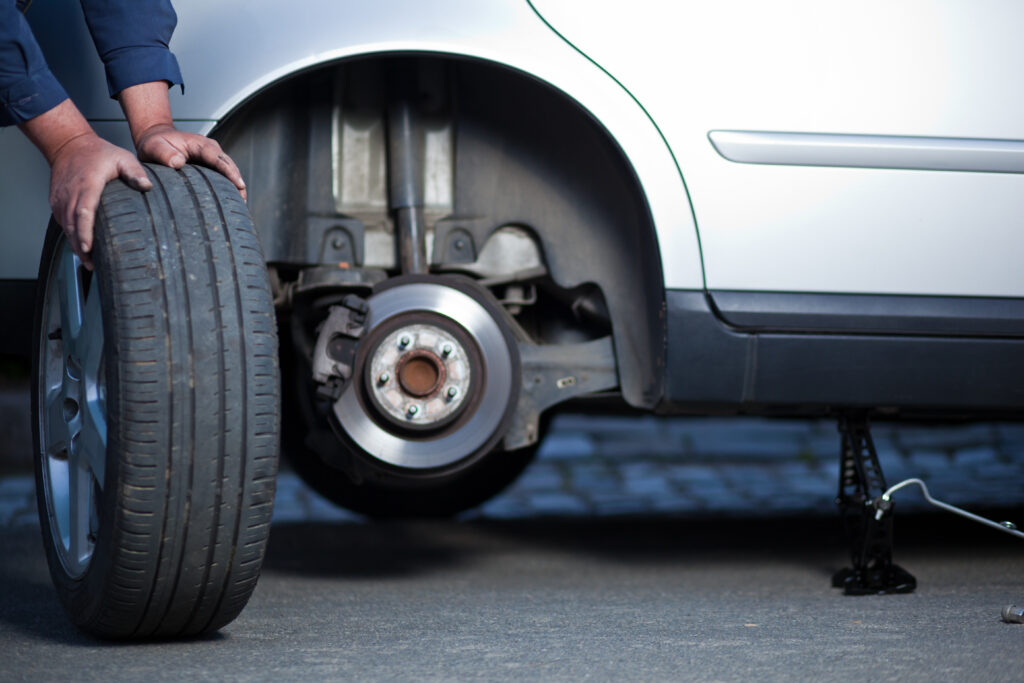When the mechanic asks if you’d like to rotate your tires, what goes through your mind? “What does that even mean?” “Didn’t I just get that done?” “Absolutely, yes, thank you for doing that.” Sometimes the mechanic doesn’t ask, and the process is included on the receipt after an oil change.
The truth is that rotating your tires is a significant step in preserving the longevity of your tires. By evening out the tread across all four, the process makes for a safer and better vehicular performance. To keep yourself safe and to keep your vehicle in peak condition, you must be sure to regularly rotate your tires.

What Does It Mean to Rotate Your Tires?
Rotating your vehicle’s tires is the process of moving each of them to different positions on your vehicle. Because front and rear tires wear down at different rates, this should be done periodically for best results. It is common to take care of the process when you get your vehicle’s oil changed.
Tire rotation is performed systematically. While the patterns on how each tire is removed and replaced vary, the idea is to move the front tires to the back (and vice versa) and to move the left tires to the right (and vice versa). By doing this, the tires with the most wear on the inside edge can spend time wearing down the outside of the tire.
Tires on a car with front-wheel drive, unsurprisingly, wear out more quickly on the front of the car. They take the brunt of the friction and torque of the vehicle as it turns, brakes, and accelerates. Rotating such tires to the back after a certain amount of usage evens out the damage. The reverse is true for cars with rear-wheel drive, and the result of rotating your tires on that kind of vehicle is the same.
A person’s driving habits and the terrain on which the vehicle is frequently driven have a profound effect on tire wear as well. If a driver tends to slam on the brakes, that will be reflected in how evenly (or, rather, unevenly) the tread wears down. The weight distribution of the car also plays a role.

Is Tire Rotation Necessary?
In terms of the vehicle itself, there are no cons to getting your tires rotated systematically. The process maximizes the life of your tires, allowing them to wear down evenly. This also allows you to save money because the intervals between when tires need to be replaced is longer than if you don’t rotate your tires.
Regularly rotating your tires means better performance of those tires and, consequently, a safer and smoother ride. Even tread gives you better traction on the road, meaning your vehicle is less likely to skid or slip or hydroplane. This also makes for a more fuel-efficient ride, which can only be exciting with gas prices being what they are. Rotating your tires regularly also provides the opportunity to check their tread depth, visually inspect them for damage, monitor their air pressure, and have them rebalanced if the need arises.
How Often Should You Rotate Your Tires?
The general recommendation is that you rotate your tires every 5,000 to 7,500 miles. The exact mileage right for your make, model, and year will be included in your car’s manual, taking into account your vehicle’s system (front-, rear-, or all-wheel drive) and the kind of transmission (automatic or manual) it has. A mileage value is more beneficial than a temporal one, because even if you don’t drive much, you still have a relevant metric to know when to take your car in and have the tires rotated.
Many mechanics will rotate your tires as part of an oil change service, at no extra cost. In other cases, tire rotation costs may be covered by warranty if you purchased the tires from the autobody shop in question. Check with your preferred mechanic to discover the policy in place.

What Does It Mean to Balance Your Tires?
During the tire balancing process, the weight imbalance on tires and wheel assemblies are measured and corrected. This is different from an alignment, which adjusts the angles at which the tires contact the road, ensuring they are even and effective. Tires are not evenly weighted, and balancing them makes sure the heavy spot of the tire and wheel assembly is counteracted to eliminate vibration. If this is not done correctly, or when the process needs to be completed, you may feel such vibrations as you handle the steering wheel. It is wise to check your tires’ balance when you rotate your tires.




Leave a Reply